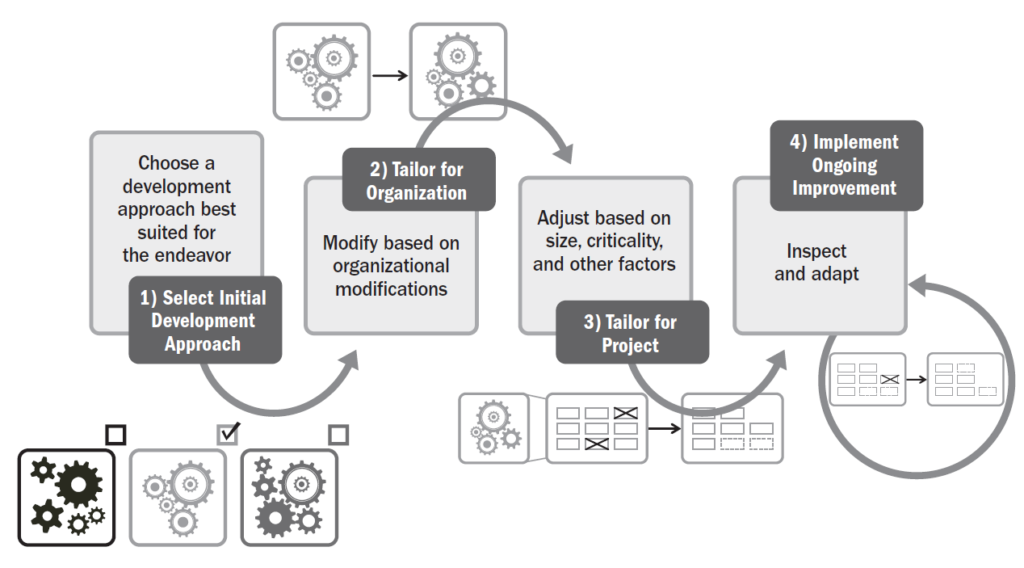Tailoring the Performance Domains – Delivery
Introduction
In the PMBOK® Guide – Seventh Edition, the Delivery Performance Domain focuses on the processes and activities required to deliver project outputs that provide value to stakeholders. However, not every project operates in the same environment or under the same constraints. Hence, tailoring this domain becomes a vital responsibility of the project team and leadership.
Tailoring is the act of selecting and adapting methods, practices, and processes to suit the project’s unique context. In the case of the Delivery domain, tailoring helps align the project’s approach, cadence, deliverables, and methods with stakeholder expectations, organizational goals, and delivery success factors.
Understanding the Delivery Performance Domain
The Delivery domain encompasses all aspects of producing, validating, and transferring deliverables. It includes:
- Defining what will be delivered
- Determining how and when it will be delivered
- Ensuring the deliverables meet quality expectations
- Confirming value delivery to stakeholders
Tailoring this domain ensures that delivery practices are efficient, effective, and relevant, instead of rigid and misaligned with the project’s environment.
Why Tailor the Delivery Domain?
Every project has a unique blend of:
- Business goals and outcomes
- Stakeholder expectations
- Risk tolerance
- Organizational culture
- Team composition
- Delivery environment (agile, predictive, or hybrid)
Tailoring the Delivery domain enables project leaders to address these nuances proactively and create a delivery strategy that maximizes success.
Benefits of tailoring the Delivery domain:
- Better alignment with strategic objectives
- Higher stakeholder satisfaction
- Optimal use of team skills and resources
- Greater flexibility in responding to change
- Efficient delivery of value
Factors to Consider When Tailoring the Delivery Domain
When tailoring delivery-related practices, several factors must be evaluated. The PMBOK Guide outlines a principle-based approach, emphasizing outcomes over rigid procedures.
1. Development Approach (Agile, Predictive, Hybrid)
- Predictive: Focuses on upfront planning and linear delivery of scope.
- Agile/Iterative: Involves continuous delivery of small increments.
- Hybrid: A mix tailored to various components of the project.
Tailoring should ensure that the chosen approach aligns with delivery complexity, feedback loops, and value realization.
2. Stakeholder Engagement
Different stakeholders have different definitions of “value.” Tailoring delivery ensures:
- The right deliverables are prioritized
- Feedback is integrated into the delivery process
- Communication is customized for stakeholder understanding
3. Organizational Environment and Culture
Tailoring must consider the organization’s maturity level, policies, and readiness to adopt new delivery methods.
- Are agile practices supported?
- Is the organization risk-averse or innovative?
- How rigid or flexible are governance structures?
4. Project Size and Complexity
Large, complex projects may require layered delivery frameworks, while smaller projects can benefit from lightweight methods.
- Modular tailoring helps divide delivery responsibilities
- Integration management ensures consistency across teams
5. Team Capabilities and Experience
Tailor delivery processes to suit the strengths and limitations of the team.
- Skilled agile teams may thrive in a Scrum or Kanban-based delivery.
- Less experienced teams might benefit from structured workflows.
Tailoring Considerations for Key Delivery Activities
Let’s explore specific delivery activities and how they can be tailored:
1. Defining Deliverables
Tailor the scope definition and WBS based on:
- Stakeholder needs
- Delivery cadence
- Complexity of work packages
Use epics/stories in agile or detailed work packages in predictive models.
2. Scheduling and Cadence
Tailor the schedule to fit:
- Business deadlines
- Resource availability
- Feedback and learning cycles
Agile uses timeboxes (sprints), while predictive approaches use milestone planning.
3. Quality Assurance and Testing
Adapt QA practices to project type:
- Predictive: Structured QA/testing after development
- Agile: Continuous integration and testing in iterations
Tailor QA checklists and approval processes to avoid delays and overburdening teams.
4. Delivery Governance and Approval
Adjust governance practices to suit the project’s size and risk profile.
- For low-risk projects: Lightweight governance
- For high-stakes projects: Formal gates and reviews
Make the governance structure lean but accountable.
5. Value Measurement and Feedback
Tailor metrics based on delivery method:
- Predictive: Measure scope, cost, and schedule performance (e.g., EVM)
- Agile: Measure delivered value per iteration (e.g., velocity, cycle time)
Use value-based metrics to adjust future deliverables.
Example of Tailoring the Delivery Domain
Scenario: Software Implementation Project for a Healthcare Provider
- Context: Strict compliance requirements, diverse stakeholder group, tight deadline
- Tailoring Actions:
- Chose a hybrid delivery method: Agile sprints for feature development, predictive planning for infrastructure and compliance
- Implemented frequent demos for stakeholders
- Customized the approval process to include compliance checkpoints
- Used burn-down charts and EVM together to track progress
This tailoring enabled faster delivery of features while maintaining oversight and ensuring regulatory compliance.
Tailoring Pitfalls to Avoid
- Over-customizing delivery processes to the point of inconsistency
- Ignoring team capabilities during tailoring
- Failing to involve stakeholders in tailoring decisions
- Rigidly applying agile or predictive models without adaptation
- Not reviewing tailoring decisions periodically
Best Practices for Tailoring the Delivery Domain
- Start with clear delivery objectives
- Involve stakeholders early in tailoring decisions
- Document tailoring decisions and rationale
- Continuously assess delivery performance and adjust
- Foster a learning culture within the team
Conclusion
Tailoring the Delivery Performance Domain is not just a best practice—it’s a necessity in modern project environments. By aligning delivery practices with project context, team strengths, and stakeholder needs, project managers enhance the probability of success and deliver true business value. Tailoring should be intentional, iterative, and well-documented, ensuring flexibility without sacrificing accountability.
By mastering the art of tailoring, project professionals can transform delivery from a process-driven formality into a value-generating engine.



